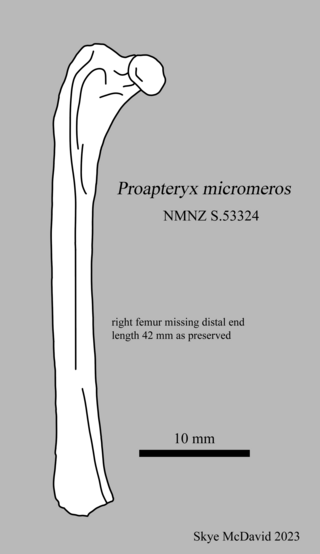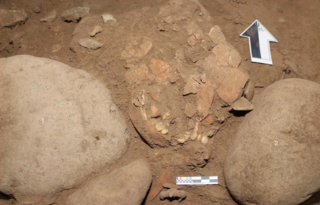Related Research Articles

Moa are an extinct group of flightless birds formerly endemic to New Zealand. During the Late Pleistocene-Holocene, there were nine species. The two largest species, Dinornis robustus and Dinornis novaezelandiae, reached about 3.6 metres (12 ft) in height with neck outstretched, and weighed about 230 kilograms (510 lb) while the smallest, the bush moa, was around the size of a turkey. Estimates of the moa population when Polynesians settled New Zealand circa 1300 vary between 58,000 and approximately 2.5 million.

Beth Alison Shapiro is an American evolutionary molecular biologist. She is a professor in the Department of Ecology and Evolutionary Biology at the University of California, Santa Cruz. Shapiro's work has centered on the analysis of ancient DNA. She was awarded a MacArthur Fellowship in 2009 and a Royal Society University Research Fellowship in 2006.

Ancient DNA (aDNA) is DNA isolated from ancient specimens. Due to degradation processes ancient DNA is more degraded in comparison with contemporary genetic material. Even under the best preservation conditions, there is an upper boundary of 0.4–1.5 million years for a sample to contain sufficient DNA for sequencing technologies. The oldest sample ever sequenced is estimated to be 1.65 million years old. Genetic material has been recovered from paleo/archaeological and historical skeletal material, mummified tissues, archival collections of non-frozen medical specimens, preserved plant remains, ice and from permafrost cores, marine and lake sediments and excavation dirt. On 7 December 2022, The New York Times reported that two-million year old genetic material was found in Greenland, and is currently considered the oldest DNA discovered so far.

Palaeognathae is an infraclass of birds, called paleognaths or palaeognaths, within the class Aves of the clade Archosauria. It is one of the two extant infraclasses of birds, the other being Neognathae, both of which form Neornithes. Palaeognathae contains five extant branches of flightless lineages, termed ratites, and one flying lineage, the Neotropic tinamous. There are 47 species of tinamous, five of kiwis (Apteryx), three of cassowaries (Casuarius), one of emus (Dromaius), two of rheas (Rhea) and two of ostriches (Struthio). Recent research has indicated that paleognaths are monophyletic but the traditional taxonomic split between flightless and flighted forms is incorrect; tinamous are within the ratite radiation, meaning flightlessness arose independently multiple times via parallel evolution.

The giant moa (Dinornis) is an extinct genus of birds belonging to the moa family. As with other moa, it was a member of the order Dinornithiformes. It was endemic to New Zealand. Two species of Dinornis are considered valid, the North Island giant moa and the South Island giant moa. In addition, two further species have been suggested based on distinct DNA lineages.

In paleoanthropology, the recent African origin of modern humans or the "Out of Africa" theory (OOA) is the most widely accepted model of the geographic origin and early migration of anatomically modern humans. It follows the early expansions of hominins out of Africa, accomplished by Homo erectus and then Homo neanderthalensis.

The Denisovans or Denisova hominins(di-NEE-sə-və) are an extinct species or subspecies of archaic human that ranged across Asia during the Lower and Middle Paleolithic. Denisovans are known from few physical remains; consequently, most of what is known about them comes from DNA evidence. No formal species name has been established pending more complete fossil material.
Bullying in academia is a form of workplace bullying which takes place at institutions of higher education, such as colleges and universities in a wide range of actions. It is believed to be common, although has not received as much attention from researchers as bullying in some other contexts. Academia is highly competitive and has a well defined hierarchy, with junior staff being particularly vulnerable. Although most universities have policies on workplace bullying, individual campuses develop and implement their own protocols. This often leaves victims with no recourse.
Richard High Ebright is an American molecular biologist. He is the Board of Governors Professor of Chemistry and Chemical Biology at Rutgers University and Laboratory Director at the Waksman Institute of Microbiology.
The Laschamp or Laschamps event was a geomagnetic excursion. It occurred between 42,200 and 41,500 years ago, during the end of the Last Glacial Period. It was discovered from geomagnetic anomalies found in the Laschamps lava flows in Clermont-Ferrand, France in the 1960s.
Roger Everett Summons is the Schlumberger Professor of Geobiology at the Massachusetts Institute of Technology and Professor of Geobiology in the Department of Earth, Atmospheric and Planetary Sciences.
Levon Michael Khachigian is an Australian medical research scientist notable for his work in vascular cell and molecular biology. He is a Professor in the Faculty of Medicine at the University of New South Wales.

Proapteryx micromeros is an extinct kiwi known from the 16–19 million-year-old early Miocene sediments of the St Bathans Fauna of Otago, New Zealand.

Notopalaeognathae is a clade that contains the order Rheiformes (rheas), the clade Novaeratitae, and the clade Dinocrypturi. The exact relationships of this group, including its recently extinct members, have only recently been uncovered. The two lineages endemic to New Zealand, the kiwis and the extinct moas, are not each other's closest relatives: the moas are most closely related to the Neotropical tinamous, and the kiwis are sister to the extinct elephant birds of Madagascar, with kiwis and elephant birds together sister to the cassowaries and emu of New Guinea and Australia. The South American rheas are either sister to all other notopalaeognaths or sister to Novaeratitae. The sister group to Notopalaeognathae is Struthionidae.

Cyclooctadeca-1,3,5,7,9,11,13,15,17-nonayne or cyclo[18]carbon is an allotrope of carbon with molecular formula C
18. The molecule is a ring of eighteen carbon atoms, connected by alternating triple and single bonds; thus, it is a polyyne and a cyclocarbon.
Nicole Lise Boivin is an archaeologist and former director of the Max Planck Institute for the Science of Human History.
Greger John Larson is an evolutionary geneticist notable for his work on animal domestication, ancient DNA, human and animal dispersal, and phylogenetics. He is a professor in the School of Archaeology, University of Oxford, and Director of the Wellcome Trust Palaeogenomics and Bio-Archaeology Research Network.

Besséʼ is the prehistoric fossil of a young woman over 7,200 years old found in the Indonesian island of Sulawesi. Discovered at Leang Panninge at the Maros Regency by archaeologists from the University of Hasanuddin in 2015, its formal description including genome sequencing was published in Nature in 2021. As the first human remain discovered belonging to the Toalean people, it provides critical understanding to human culture and migration during the Holocene period of Asia. The nickname is adopted from the Bugis's custom of affectionately calling their newborn baby girls.
Morteza Mahmoudi is an Iranian-American nanotechnologist and Assistant Professor in the Department of Radiology at Michigan State University. Previously, he was an assistant professor at Harvard University. Mahmoudi is a winner of 2018 BRIght Futures Prize, 2018 IGNITE Award, and 2016 USERN Prize. He is best known for his works on academic bullying; he is also a co-founder of a non-profit organization called the Academic Parity Movement which is focused on addressing academic bullying issue in various disciplines.
Ian Barnes is an evolutionary geneticist notable for his work on ancient DNA, human and animal migration, and phylogenetics. Barnes is a Research Leader in the Department of Earth Sciences at the Natural History Museum in London.
References
- ↑ Ross, John (5 July 2018). "Interview with Alan Cooper" . Times Higher Education. Retrieved 28 March 2020.
- ↑ "Alan Cooper". Royal Institution of Australia. 30 April 2005. Archived from the original on 18 January 2015. Retrieved 29 March 2020.
- 1 2 3 Lewis, Dyani (21 December 2019). "Head of ancient-DNA lab sacked for 'serious misconduct'". Nature . doi:10.1038/d41586-019-03932-3. PMID 33340012. S2CID 212810656.
- 1 2 Howes, Ted (10 July 2023). "Dismissed DNA professor rehired at CSU's Border campus". The Border Mail. Retrieved 14 September 2023.
- 1 2 Cooper, Alan (1994). Molecular evolutionary studies of New Zealand birds. tewaharoa.victoria.ac.nz (PhD thesis). Victoria University of Wellington. OCLC 154061907.[ permanent dead link ]
- ↑ "Research Profiles: Professor Alan Cooper". Archived from the original on 17 July 2019. Retrieved 22 July 2019.
- ↑ Pincock, Stephen (1 June 2005). "Oxford DNA Lab Leaderless". The Scientist Magazine. Archived from the original on 23 July 2020. Retrieved 15 May 2021.
- ↑ "16 new Australian Laureate Fellows to push the boundaries of research". Australian Research Council. 22 October 2014. Retrieved 29 March 2020.
- ↑ Lewis, Dyani (23 August 2019). "'Paralysed by anxiety': researchers speak about life in troubled ancient-DNA lab". Nature. 572 (7771): 571–572. Bibcode:2019Natur.572..571L. doi: 10.1038/d41586-019-02540-5 . PMID 31455916. S2CID 201656835.
- ↑ Lewis, Dyani (19 August 2019). "Head of prestigious ancient-DNA lab suspended amid bullying allegations". Nature. 572 (7770): 424–425. Bibcode:2019Natur.572..424L. doi: 10.1038/d41586-019-02490-y . PMID 31431750.
- ↑ Culotta, Elizabeth (19 August 2019). "Australian university suspends ancient DNA expert Alan Cooper as part of workplace investigation". Science . doi:10.1126/science.aaz1830. S2CID 202354006.
- ↑ Lewis, Dyani (19 August 2019). "Head of prestigious ancient-DNA lab suspended amid bullying allegations". Nature. 572 (7770): 424–425. Bibcode:2019Natur.572..424L. doi: 10.1038/d41586-019-02490-y . PMID 31431750. S2CID 201105764.
- ↑ Wadman, Meredith (20 December 2019). "Bullying allegations lead to firing of prominent ancient DNA expert". Science . doi:10.1126/science.aba6622. S2CID 214460564.
- 1 2 Lewis, Dyani (28 June 2023). "Ancient-DNA researcher fired for 'serious misconduct' lands new role". Nature. doi:10.1038/d41586-023-02147-x. PMID 37380840. S2CID 259285719.
- ↑ Cooper, A. (2000). "Ancient DNA: Do It Right or Not at All". Science. 289 (5482): 1139b–1139. doi:10.1126/science.289.5482.1139b. ISSN 0036-8075. PMID 10970224. S2CID 11030200.
- ↑ Cooper, Alan; Lalueza-Fox, Carles; Anderson, Simon; Rambaut, Andrew; Austin, Jeremy; Ward, Ryk (2001). "Complete mitochondrial genome sequences of two extinct moas clarify ratite evolution". Nature. 409 (6821): 704–707. doi:10.1038/35055536. ISSN 0028-0836. PMID 11217857. S2CID 4430050.
- ↑ Kahn, Jennifer. "Canada's Ancient Monsters on Ice", Discover , 28 March 2004. Retrieved on 18 October 2014
- ↑ Adler, Christina J; Dobney, Keith; Weyrich, Laura S; Kaidonis, John; Walker, Alan W; Haak, Wolfgang; Bradshaw, Corey J A; Townsend, Grant; Sołtysiak, Arkadiusz; Alt, Kurt W; Parkhill, Julian; Cooper, Alan (2013). "Sequencing ancient calcified dental plaque shows changes in oral microbiota with dietary shifts of the Neolithic and Industrial revolutions". Nature Genetics . 45 (4): 450–455. doi:10.1038/ng.2536. ISSN 1061-4036. PMC 3996550 . PMID 23416520.
- ↑ Cooper, Alan; Turney, Chris S. M.; Palmer, Jonathan; Hogg, Alan; McGlone, Matt; Wilmshurst, Janet; Lorrey, Andrew M.; Heaton, Timothy J.; Russell, James M.; McCracken, Ken; Anet, Julien G. (19 February 2021). "A global environmental crisis 42,000 years ago". Science. 371 (6531): 811–818. doi:10.1126/science.abb8677. ISSN 0036-8075. PMID 33602851. S2CID 231955607.
- ↑ Voosen, Paul (19 February 2021). "Kauri trees mark magnetic flip 42,000 years ago". Science. 371 (6531): 766. Bibcode:2021Sci...371..766V. doi:10.1126/science.371.6531.766. ISSN 0036-8075. PMID 33602836. S2CID 231963027.
- ↑ 2017 Australian Museum Eureka Prizes winners, Australian Museum. Retrieved on 8 August 2019
- ↑ "Professor Alan Cooper is SA Scientist of the Year" Retrieved on 16 July 2019
- ↑ "Australian Research Council Laureate Fellowship: Alan Cooper" Archived 11 March 2015 at the Wayback Machine "Australian Research Council" Archived 22 November 2014 at the Wayback Machine Retrieved on 7 December 2014
- ↑ "Australian Centre for Ancient DNA: Research" Retrieved on 7 December 2014
- ↑ "Australian Research Council Future Fellowships 2009" Archived 10 March 2015 at the Wayback Machine "Australian Research Council" Archived 22 November 2014 at the Wayback Machine Retrieved on 7 December 2014
- ↑ "Australian Research Council Federation Fellowships 2004" Archived 7 July 2012 at the Wayback Machine "Australian Research Council" Archived 22 November 2014 at the Wayback Machine Retrieved on 7 December 2014
- ↑ "Annual Report of the Institute of Zoology 2001/02" [Zoological Society of London] Retrieved on 7 December 2014
- ↑ "The Walter M. Fitch Award". www.smbe.org. Archived from the original on 12 August 2020. Retrieved 23 March 2020.
- ↑ "Ernst Mayr Award". Society of Systematic Biologists. Retrieved 23 March 2020.